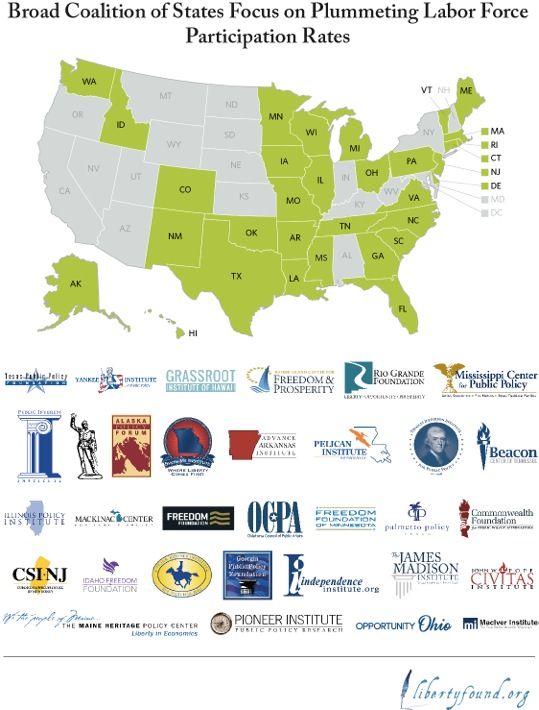This Tuesday, Americans will head to the polls to determine the direction of the country for the next two years. Control of the U.S. Senate is the focus of the political class in Washington. For many Americans, however, the focus remains on jobs and the meek economic recovery they have experienced over the last six years.
They hear politicians brag that the unemployment rate is at 5.9 percent, yet they see how they and their neighbors continue to struggle to make ends meet. This struggle is tied to the alarming decline of the Labor Force Participation Rate (LFPR). The LFPR measures the number of Americans who are working and looking for work. The latest government release places the LFPR at 62.7 percent, which is the lowest rate since Jimmy Carter’s presidency.
Because The Liberty Foundation of America works in every state, we dug into the LFPR for all fifty states and the District of Columbia to see what was really happening to America’s workforce. The data from 1999 through 2013 shows a staggering drop over the last several years, especially for minorities and women in nearly every state. Although it is hard to lay the blame on any one person or policy, with the same results state-after-state, it is clear the issue has much more to do with federal policies than retirements or the cornucopia of policies being enacted in the states.

From the ObamaCare mandates to the Environmental Protection Agency’s war on carbon, to pro-union versus pro-worker executive actions, to the global instability created by a weak foreign policy, employers face a tepid global economy rife with uncertainty. These federal failures for once align the Beltway’s obsession with control of the U.S. Senate with the concern Americans have on jobs. That means we have a rare chance to exert our voices loudly.
Make no mistake, elections matter, because the policy actions or inactions that follow have a direct impact on family budgets and opportunities. To help Americans make the most informed decisions as politicians promote their policy views, The Liberty Foundation partnered with groups in 32 states on an aggressive education effort focused on jobs and the LFPR.
With our state partners, we released easy-to-understand charts showing the LFPR by gender and race for every state and DC, as well as the 15 years of data broken down by gender, race and age. You can see your state’s charts and information at www.libertyfound.org.
Here’s the Short Version of the Jobs Picture in States
Here are a few key highlights showing what happened from 2008 to 2013:
In Alaska, the LFPR dropped by 3.4 percent for all Alaskans, and five points for all working-aged men.
Arkansas experienced a more severe drop in the LFPR. The rate for Hispanics plummeted by 10.5 points, with Hispanic men nearly 13 points lower. Women aged 25 to 44 also saw their LFPR decline by more than ten points, and African-Americans got hit with a six-point drop.
The story in Colorado is equally grim. Hispanic men again suffered the most, as they saw their LFPR fall by nearly nine points. All Colorado men experienced a 5.7-point drop. For young men and women aged 16 to 24 trying to enter the workforce, the LFPR decreased by more than 4.5-points.
Iowa is another state with a depressing jobs picture for Hispanics and younger workers. Specifically, the LFPR for Hispanic men went down almost 11 points—six-plus points for all Hispanics, as Iowans aged 16 to 24 left the workforce by more than seven points.
Louisiana’s African-American workers suffered a 4.7-point drop, and men aged 35 to 44 experienced a 7.1-point decline.
In North Carolina, young men and women aged 16 to 24 dropped out of the workforce by five points, as the rate for Hispanic men declined by more than six points.
State after state, the story remains the same. This reality presents free-market proponents with a unique opportunity to reach out to the minority communities that typically don’t pay us much attention on the single most important issue to them: jobs. Because this opportunity exists when America’s policy direction will be decided makes it all the more compelling.
If we can connect with the sizeable number of Americans who were dealt a raw jobs deal over the past six years, not only can we impact the policy direction over the next two years, but we can spark a dialogue with long-term implications both for who governs America and how they do so.
More of the same just won’t cut it.









